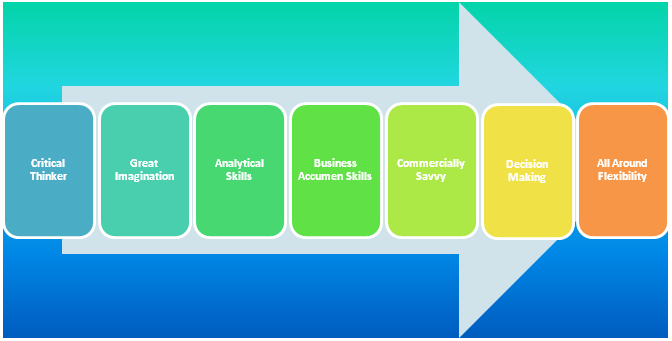How to Become a Successful Business Analyst
Business analysis is a research based discipline to identify business requirement and determine the solutions to many issues faced while operating a business. Apart from the development components of the software-systems, various solutions to the problems include organizational change, process improvement, strategic planning and policy development. Learning business analysis can enhance your expertise as an adept business analyst.
Steps involved in Business Analysis and the key responsibilities of a Business Analyst are:

Step 1: Get Oriented
The first step of business analysis is getting acquainted with the project. Sufficient time should be spent to understand the scope, objectives and requirements of the project, so that it is carried out effectively without any glitches.
Responsibilities:
- Identifying and determining the primary stakeholders to employ in outlining the scope and objectives of the project. The stakeholders vary from one project to another and include suppliers, customers, external auditors, regulatory officials and financial reporting experts.
Step 2: Discover the Primary Business Objectives
The next step is to discover and understand the objectives of a project before plunging directly into the scope of the project.
Responsibilities:
- Ensuring that the business objectives are well defined and can be executed. A vital responsibility of a BA professional is to realize the expectations of the project from the primary stakeholders.
Step 3: Define Scope
The third step in the process of business analysis is to define and understand the scope of the project. The scope of a project makes the requirement of a business feasible so that the multiple participants of the team can visualize their contribution to the project and the implementation of it.
Responsibilities:
- Defining an approach to the solution, so that the extent and nature of the technology to be employed can be determined and certain alterations can be made to the business process before implementing it as a solution to satisfy the primary business objectives.
- As a business analyst you should draft a scope statement and review it with the prime technology stakeholders.
Step 4: Formulate Your Business Analysis Plan
As a business analyst you should device a feasible business analysis plan that can be made use of to define the requirement of the project. This business plan could act as a guide and answer important queries for your project team while the project is in operation.
Responsibilities:
- Selecting the most suitable business analysis deliverables keeping in mind the method, scope and other vital aspects of the project.
- The deliverables of the project should be clearly elucidated and the prime stakeholders of the project should be identified who would be part of the designing and acceptance of the deliverables.
Step 5: Define the Detailed Requirements
This is an important step as without precise and actionable requirements, the project team would fail to implement the business plan effectively. As an efficient business analyst, the deliverables should be properly sequenced for the success of the project.
Responsibilities:
- After procuring information and analyzing it, a draft should be prepared coveringthe deliverables and the requirements of the project.
- As a proficient BA, you should identify the requirements of the stakeholders and should review and confirm each deliverable with the suitable stakeholders and should ask questions by means of questionnaires, surveys, interviews and spontaneous group discussions to fill gaps.
Step 6:Identifying the Current Business Process and Analyzing the Difference
With the help of modeling, reviewing of documentation and research, the ongoing business process is identified and the difference between the stake holders’ requirements and the current business process are analyzed and any issues thereby are addressed.
Responsibilities:
- The duty of a competent business analyst is to ascertain the unmet requirements of a stake holder and fixing the issues.
Step 7: Help the Business Implement the Solution
This is the final step of the business analysis and involvement of a business analyst in this stage is very important to ensure that the business users are ready to embrace the changes mentioned in the project. Otherwise the efforts of the business analyst and technical team go in waste.
Responsibilities:
- Training the end-users so that they understand the changes and accept them.
These steps would act as a guide to help you to emerge as a successful business analyst, which is a very promising career. You can hone your skills with business analysis training and land yourself a high profile job in one of the reputed companies.
Find a course provider to learn BA
Java training | J2EE training | J2EE Jboss training | Apache JMeter trainingTake the next step towards your professional goals in BA
Don't hesitate to talk with our course advisor right now
Receive a call
Contact NowMake a call
+1-732-338-7323Take our FREE Skill Assessment Test to discover your strengths and earn a certificate upon completion.
Enroll for the next batch
Business Analysis Hands-on Training with Job Placement
- Jun 20 2025
- Online
Related blogs on BA to learn more

Why Learn to Analyze Business Needs and Deliver Results as a Business Analyst?
Discover the key skills of a Business Analyst, including problem-solving, stakeholder engagement, data analysis, and solution delivery, to make informed decisions and achieve business goals.

What is the importance of acquiring business requirement skills in a BA course?
Learn the technical and non-technical skills required for Business Analysts, and how Sulekha's comprehensive BA course equips you to excel in today's competitive market.

Is Business Analyst a High-Paying Job? Top Hiring Companies
Learn about the high-paying Business Analyst role, with insights on salary, job growth, top companies hiring, and how to get started in this thriving field.

Importance of data-driven decision-making in organizations
Discover the importance of data-driven decision-making in organizations, including a 6-step process to collect, analyze, and act on data to drive business success.

What is Business Mathematics?
Explore the essential role of Business Mathematics in solving financial, operational, and marketing challenges across various industries, enhancing decision-making and efficiency.

What is Microeconomics?
Explore microeconomics, the study of individual and firm decisions on resource allocation, pricing, and market behavior. Learn about key concepts like supply, demand, and equilibrium.

What is Business?
Explore the essential concepts of business, from its characteristics and types to its role in the economy. Gain insights into different business structures and their significance.

What is business communication?
Learn about business communication, its types, objectives, and essential aspects to enhance workplace communication. Discover effective strategies for sharing information within and outside your organization.

What Is a Business Analyst? A comprehensive guide
What is a Business Analyst? - A comprehensive guide exploring the role of a business analyst

Why is it important to utilize both planning and analytical skill together?
Effective decision-making requires combining planning and analytical skills to gather insights, prioritize goals, and make informed strategic choices.
Latest blogs on technology to explore

What Does a Cybersecurity Analyst Do? 2025
Discover the vital role of a Cybersecurity Analyst in 2025, protecting organizations from evolving cyber threats through monitoring, threat assessment, and incident response. Learn about career paths, key skills, certifications, and why now is the be

Artificial intelligence in healthcare: Medical and Diagnosis field
Artificial intelligence in healthcare: Medical and Diagnosis field

iOS 18.5 Is Here: 7 Reasons You Should Update Right Now
In this blog, we shall discuss Apple releases iOS 18.5 with new features and bug fixes

iOS 18.4.1 Update: Why Now is the Perfect Time to Master iPhone App Development
Discover how Apple’s iOS 18.4.1 update (April 2025) enhances security and stability—and why mastering iPhone app development now is key to building future-ready apps.

What is network security Monitoring? A complete guide
In the digital world, we have been using the cloud to store our confidential data to register our details; it can be forms, applications, or product purchasing platforms like e-commerce sites. Though digital platforms have various advantages, one pri

How to Handle Complex and Challenging Projects with Management Skills
Discover actionable strategies and essential management skills to effectively navigate the intricacies of challenging projects. From strategic planning to adaptive problem-solving, learn how to lead your team and achieve exceptional outcomes in compl

What are the 5 phases of project management?
A streamlined approach to ensure project success by breaking it into five essential stages: Initiation, Planning, Execution, Monitoring & Controlling, and Closing. Each phase builds on the other, guiding the team from concept to completion with clear

About Microsoft Job Openings and Certification Pathway to Explore Job Vacancies
Explore exciting Microsoft job openings across the USA in fields like software engineering, data science, cybersecurity, and more. Enhance your career with specialized certifications and land top roles at Microsoft with Sulekha's expert courses.
- Business Process Analyst
- Oracle Business Analytics
- Facets Business Analyst
- Business Intelligence Analyst
- Functional Analyst
- Insurance Business Analyst
- BA Supply Chain Management
- IT Business Analyst
- Generative AI For Business Intelligence
- AI In Business Analytics
- Business Analyst Finance Domain
- Agile Business Analyst
